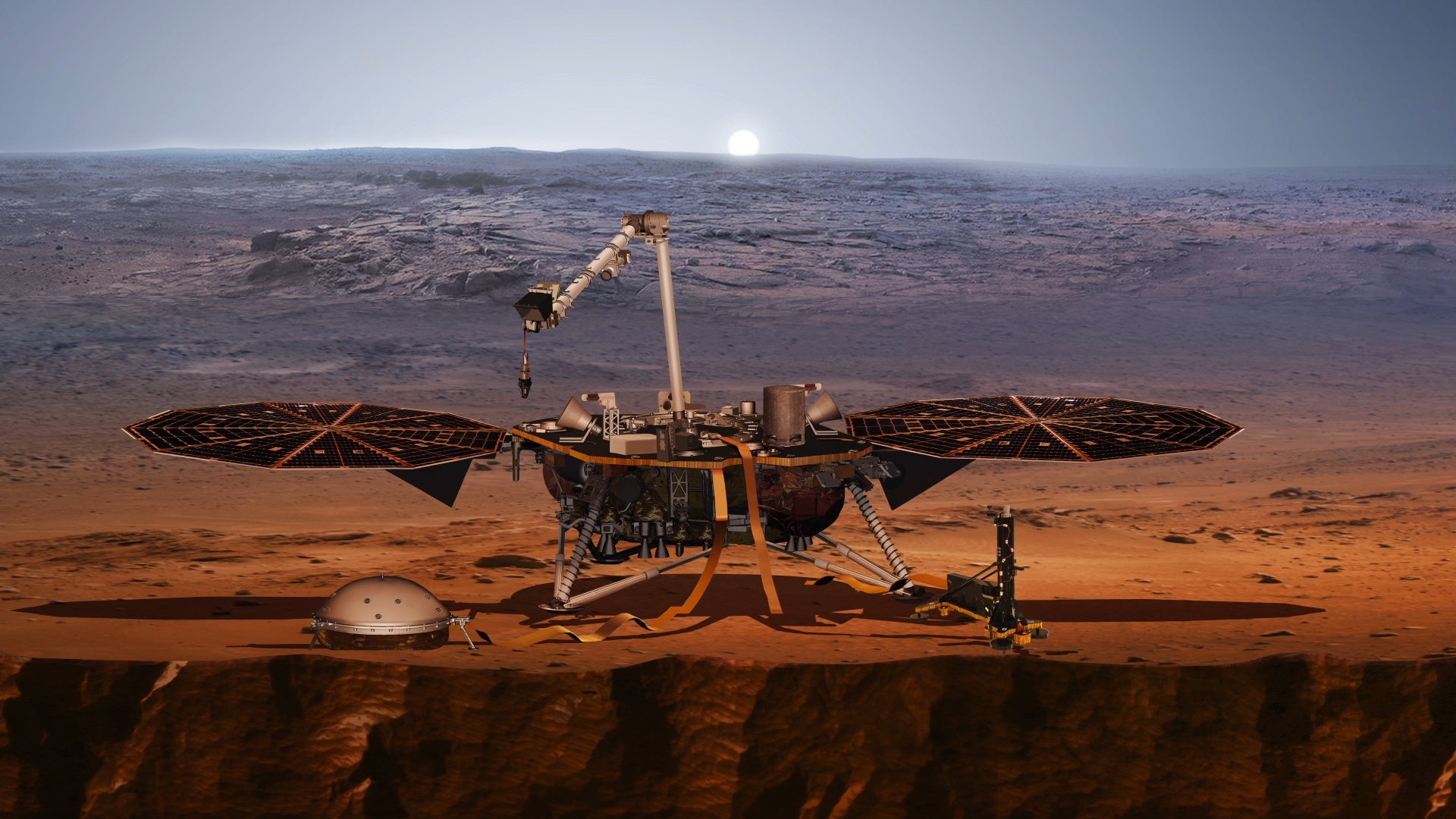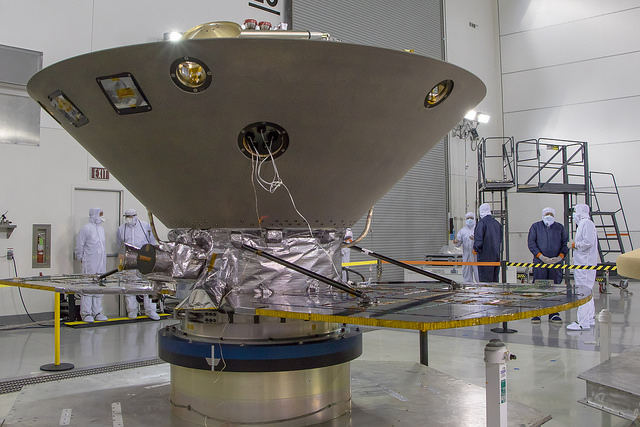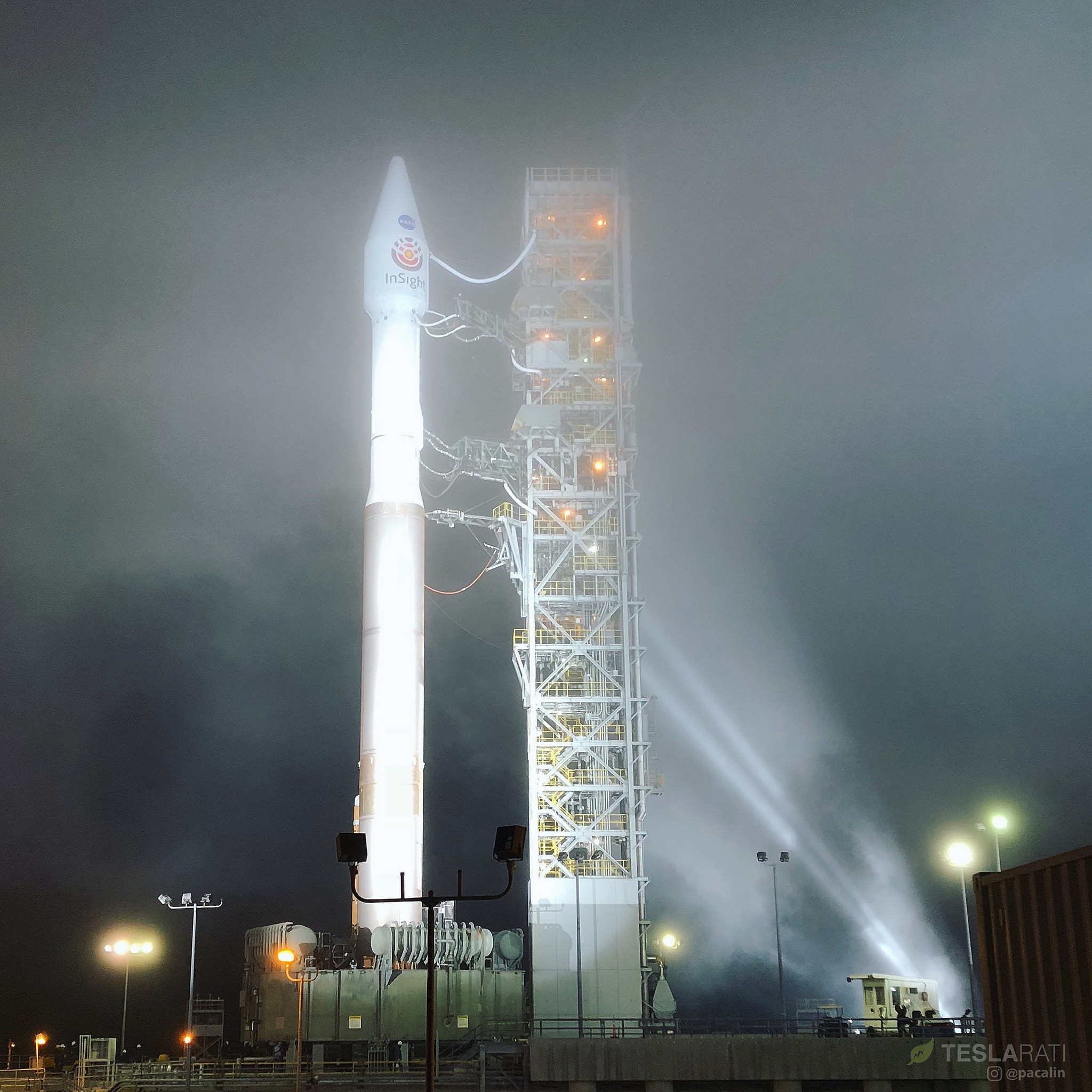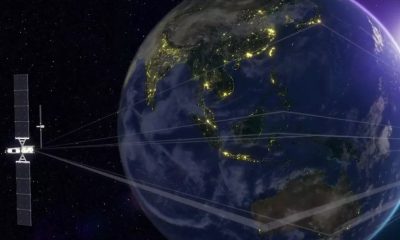

News
NASA to livestream first Mars landing in six years on November 26 with InSight lander
On Monday, November 26, 2018, a Mars lander will arrive on the surface of the red planet for the first time in six years, and NASA will broadcast the event live on their TV channel and website. The craft’s name is “InSight”, and it’s scheduled to complete its journey begun May 5, 2018 on an Atlas V rocket by setting down onto Martian regolith at approximately 3 pm EST. A video stream of Mission Control at the Jet Propulsion Laboratory in California will be available where viewers can listen to live landing commentary. InSight’s descent itself will not have a video component; however, photographs of the craft while parachuting and shortly after landing may be transmitted.
Truly enjoyed the experience of my first AtlasV launch, and all the excitement surrounding this incredible mission! Rather surprised my remote cams survived AND managed to capture *anything* in that totally rude fog. 🙂 Here are a couple shots. @NASAInSight @ulalaunch pic.twitter.com/XEH4zBLWpu
— Pauline Acalin (@w00ki33) May 5, 2018
InSight’s name is short for “Interior Exploration using Seismic Investigations, Geodesy and Heat Transport”, and as the name implies, its mission is to collect seismographic data from the surface of Mars in order to gather information about the planet’s core. The lander has six instruments on board that will propogate seismic waves through Mars’s interior after hammering a probe about 10-16 feet into the ground, a process which will take about 2-3 months to complete. The vibrations measured at the surface will then be measured and interpreted to reveal details about its layers and, by extension, the early formation of both it and Earth.
Unlike a rocket launch where delays are always possible, you can safely mark your calendar for this event. NASA can’t change this date even if they wanted to thanks to the physics involved in the lander’s interplanetary flight. If you’re interested in celebrating InSight’s Martian arrival in a community setting, watch parties open to the public are planned at scientific facilities and libraries around the world.

InSight in a clean room at Vandenberg AFB in California. | Credit: Pauline Acalin
Viewers of the live streamed landing will hear updates from scientists as they track InSight’s journey from a fiery entry speed of 12,300 mph to a 5 mph landing speed. Drag against the craft’s heat shield, parachutes, and retrorockets will slow its descent. The mission’s scientists hope to receive an image of the Martian surface shortly after, but they’ve cautioned that the initial photos will likely be cloudy due to dust kicked up from the event.
InSight will land in Mars’s Elysium Planitia (“the biggest parking lot on Mars”), an area near the planet’s equator. Its closest Earth-sent neighbor, the Curiosity rover, will be 240 miles away, and twin rovers Spirit and Opportunity will be located 1,600 and 5,200 miles away, respectively. Once on the surface, InSight’s first steps will be to unpack and deploy its solar panels to ensure power for the rest of its instruments.
The solar panels will provide about 600-700 watts on a clear Martian day, 200-300 during dustier conditions. For more perspective on this power source, NASA’s press release likened its maximum wattage to the requirements of a household blender (500 watts). The amount of energy converted just falls short of running a coffee machine (1000 watts), but plenty to “wake up” the lander after sleep, even if not a human.

As a bonus for space fans, InSight did not set out on its interplanetary mission alone. Twin demonstration mini satellites named “Mars Cube One” (MarCO) launched with the lander and traveled separately to the planet. Along with having completed successful radio, antennae, steering, and propulsion tests during their journey, MarCo will test a new kind of data relay from Mars orbit during InSight’s descent to the surface. InSight will not depend on successful transmissions to and from MarCo to land.
MarCO also marks the first deep space mission for a type of tiny satellite called “CubeSats”, a class characterized by a small form factor and miniaturized technologies that are often commercial, off-the-shelf components. MarCO fits this category and each satellite is about the size of a briefcase. The significantly lower development and launch costs of CubeSats compared to larger satellites have already opened space science to students and limited budget commercial initiatives. The success of MarCO in the deep space environment will now potentially open up interplanetary exploration beyond government agencies to encompass more civilian initiatives.
Watch NASA’s video below to learn more about the lander:
Elon Musk
Why Tesla’s Q3 could be one of its biggest quarters in history
Tesla could stand to benefit from the removal of the $7,500 EV tax credit at the end of Q3.

Tesla has gotten off to a slow start in 2025, as the first half of the year has not been one to remember from a delivery perspective.
However, Q3 could end up being one of the best the company has had in history, with the United States potentially being a major contributor to what might reverse a slow start to the year.
Earlier today, the United States’ House of Representatives officially passed President Trump’s “Big Beautiful Bill,” after it made its way through the Senate earlier this week. The bill will head to President Trump, as he looks to sign it before his July 4 deadline.
The Bill will effectively bring closure to the $7,500 EV tax credit, which will end on September 30, 2025. This means, over the next three months in the United States, those who are looking to buy an EV will have their last chance to take advantage of the credit. EVs will then be, for most people, $7,500 more expensive, in essence.
The tax credit is available to any single filer who makes under $150,000 per year, $225,000 a year to a head of household, and $300,000 to couples filing jointly.
Ending the tax credit was expected with the Trump administration, as his policies have leaned significantly toward reliance on fossil fuels, ending what he calls an “EV mandate.” He has used this phrase several times in disagreements with Tesla CEO Elon Musk.
Nevertheless, those who have been on the fence about buying a Tesla, or any EV, for that matter, will have some decisions to make in the next three months. While all companies will stand to benefit from this time crunch, Tesla could be the true winner because of its sheer volume.
If things are done correctly, meaning if Tesla can also offer incentives like 0% APR, special pricing on leasing or financing, or other advantages (like free Red, White, and Blue for a short period of time in celebration of Independence Day), it could see some real volume in sales this quarter.
You can now buy a Tesla in Red, White, and Blue for free until July 14 https://t.co/iAwhaRFOH0
— TESLARATI (@Teslarati) July 3, 2025
Tesla is just a shade under 721,000 deliveries for the year, so it’s on pace for roughly 1.4 million for 2025. This would be a decrease from the 1.8 million cars it delivered in each of the last two years. Traditionally, the second half of the year has produced Tesla’s strongest quarters. Its top three quarters in terms of deliveries are Q4 2024 with 495,570 vehicles, Q4 2023 with 484,507 vehicles, and Q3 2024 with 462,890 vehicles.
Elon Musk
Tesla Full Self-Driving testing continues European expansion: here’s where
Tesla has launched Full Self-Driving testing in a fifth European country ahead of its launch.

Tesla Full Self-Driving is being tested in several countries across Europe as the company prepares to launch its driver assistance suite on the continent.
The company is still working through the regulatory hurdles with the European Union. They are plentiful and difficult to navigate, but Tesla is still making progress as its testing of FSD continues to expand.
Today, it officially began testing in a new country, as more regions open their doors to Tesla. Many owners and potential customers in Europe are awaiting its launch.
On Thursday, Tesla officially confirmed that Full Self-Driving testing is underway in Spain, as the company shared an extensive video of a trip through the streets of Madrid:
Como pez en el agua …
FSD Supervised testing in Madrid, Spain
Pending regulatory approval pic.twitter.com/txTgoWseuA
— Tesla Europe & Middle East (@teslaeurope) July 3, 2025
The launch of Full Self-Driving testing in Spain marks the fifth country in which Tesla has started assessing the suite’s performance in the European market.
Across the past several months, Tesla has been expanding the scope of countries where Full Self-Driving is being tested. It has already made it to Italy, France, the Netherlands, and Germany previously.
Tesla has already filed applications to have Full Self-Driving (Supervised) launched across the European Union, but CEO Elon Musk has indicated that this particular step has been the delay in the official launch of the suite thus far.
In mid-June, Musk revealed the frustrations Tesla has felt during its efforts to launch its Full Self-Driving (Supervised) suite in Europe, stating that the holdup can be attributed to authorities in various countries, as well as the EU as a whole:
Tesla Full Self-Driving’s European launch frustrations revealed by Elon Musk
“Waiting for Dutch authorities and then the EU to approve. Very frustrating and hurts the safety of people in Europe, as driving with advanced Autopilot on results in four times fewer injuries! Please ask your governing authorities to accelerate making Tesla safer in Europe.”
Waiting for Dutch authorities and then the EU to approve.
Very frustrating and hurts the safety of people in Europe, as driving with advanced Autopilot on results in four times fewer injuries!
Please ask your governing authorities to accelerate making Tesla safer in Europe. https://t.co/QIYCXhhaQp
— Elon Musk (@elonmusk) June 11, 2025
Tesla said last year that it planned to launch Full Self-Driving in Europe in 2025.
Elon Musk
xAI’s Memphis data center receives air permit despite community criticism
xAI welcomed the development in a post on its official xAI Memphis account on X.

Elon Musk’s artificial intelligence startup xAI has secured an air permit from Memphis health officials for its data center project, despite critics’ opposition and pending legal action. The Shelby County Health Department approved the permit this week, allowing xAI to operate 15 mobile gas turbines at its facility.
Air permit granted
The air permit comes after months of protests from Memphis residents and environmental justice advocates, who alleged that xAI violated the Clean Air Act by operating gas turbines without prior approval, as per a report from WIRED.
The Southern Environmental Law Center (SELC) and the NAACP has claimed that xAI installed dozens of gas turbines at its new data campus without acquiring the mandatory Prevention of Significant Deterioration (PSD) permit required for large-scale emission sources.
Local officials previously stated the turbines were considered “temporary” and thus not subject to stricter permitting. xAI applied for an air permit in January 2025, and in June, Memphis Mayor Paul Young acknowledged that the company was operating 21 turbines. SELC, however, has claimed that aerial footage shows the number may be as high as 35.
Critics are not giving up
Civil rights groups have stated that they intend to move forward with legal action. “xAI’s decision to install and operate dozens of polluting gas turbines without any permits or public oversight is a clear violation of the Clean Air Act,” said Patrick Anderson, senior attorney at SELC.
“Over the last year, these turbines have pumped out pollution that threatens the health of Memphis families. This notice paves the way for a lawsuit that can hold xAI accountable for its unlawful refusal to get permits for its gas turbines,” he added.
Sharon Wilson, a certified optical gas imaging thermographer, also described the emissions cloud in Memphis as notable. “I expected to see the typical power plant type of pollution that I see. What I saw was way worse than what I expected,” she said.
-

 Elon Musk3 days ago
Elon Musk3 days agoTesla investors will be shocked by Jim Cramer’s latest assessment
-

 News1 week ago
News1 week agoTesla Robotaxi’s biggest challenge seems to be this one thing
-

 News2 weeks ago
News2 weeks agoTexas lawmakers urge Tesla to delay Austin robotaxi launch to September
-

 Elon Musk2 weeks ago
Elon Musk2 weeks agoFirst Look at Tesla’s Robotaxi App: features, design, and more
-

 Elon Musk2 weeks ago
Elon Musk2 weeks agoxAI’s Grok 3 partners with Oracle Cloud for corporate AI innovation
-

 News2 weeks ago
News2 weeks agoSpaceX and Elon Musk share insights on Starship Ship 36’s RUD
-

 News2 weeks ago
News2 weeks agoWatch Tesla’s first driverless public Robotaxi rides in Texas
-

 News2 weeks ago
News2 weeks agoTesla has started rolling out initial round of Robotaxi invites



















